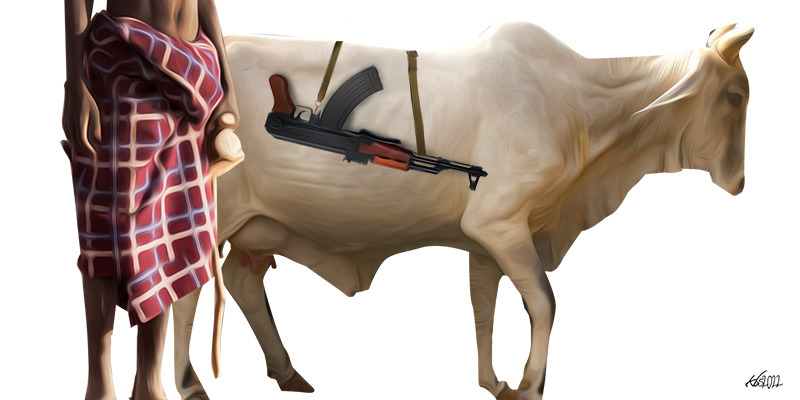The mid-1990s were a time of new beginnings in Kenya. The return of multi-party politics had accelerated the transition from the modernization prescriptions of the post-colonial era to new visions of the country’s future. In the pastoralist sector, the political and constitutional reform movement fed into the old and new frictions generating turbulence on the range. It also supercharged other streams feeding the societal awakening in the more urban environs where pastoralists congregated.
After decades of malaise and lassitude, events were moving fast. Eastleigh was becoming the significant crossroad of the Horn, a switchboard for real-time news happening across the region. The vacuum was filled by the spread of firearms, shifting economic networks undermining the older patron-client networks that survived the Kenyatta era while also fuelling the rise of a vibrant civil society. Emergent synergies fed into a new awakening of sorts across the more extensive pastoralist interface, proceeding in synch with the decomposition of the old order.
Nothing captured that moment’s zeitgeist better than the rise of a new cohort of young parliamentarians in northern Kenya.
In early 1997, a cohort of mainly younger members of parliament came together for a leaders’ meeting in Naivasha. Before the meeting, Sammy Leshore, Mohammed Shidiye, and Abdullahi Wako were called to State House to explain what they were up to. The president expressed his displeasure by banging his fist on his desk, “This meeting is not going to happen!” Nicholas Biwott nodded in agreement.
The MPs had provided the most consistent backing for KANU after the restitution of multi-party politics, but the display did not cow them: “Not this time Mzee, our meeting is going to go ahead.”
Nothing captured that moment’s zeitgeist better than the rise of a new cohort of young parliamentarians in northern Kenya.
The meeting, organized by the Kenya Pastoralist Forum, provided a watershed moment for the long-neglected pastoralist rangelands. The participating MPs — including John Munyes (Turkana North), Ekwee Ethuro (Turkana Central), Francis Ewaton (Turkana South), Sammy Leshore (Samburu West), Samuel Poghisio (Kacheliba), Geoffrey Parpai (Kajiado South), Mohamed Shidiye (Lagdera), Elias Bare Shill (Fafi), Adan Keynan (Wajir West), Abdullahi Ibrahim Ali (Wajir North), Abdi Mahamud, (Wajir East), Mohamed Abdi Affey, (Wajir South), Shaaban Issack (Mandera East), Mohammed Amin (Mandera West), Mohamed Dahir (Ijara), Abdullahi Wako (Isiolo South), Molu Shambaro (Garsen), Mohamed Galgalo (Bura), Ahmed Galgalo (Moyale) — officially launched the Pastoralist Parliamentary Group on the last day of the meeting.
I was privileged to contribute the following essay to the meeting, which foreshadowed some of the developments on the ground that followed while providing a marker for the progress realized since that time.
Pastoralism is a transhumant mode of production based on the herding of domestic livestock or migratory animals. The Sioux, Cheyenne, and other North American pastoral communities followed the herds of wild buffalo wandering across the Great Plains. The pastoralism of the Sami of northern Europe manages communally-owned herds of reindeer. Many Eskimos are pastoralists who survive on a featureless landscape of frigid tundra with seasonal shifts to the coast to harvest seals. African pastoralism, in contrast, is associated exclusively with cattle, camels, and small ruminants. The viability of these societies is a function of their symbiotic relationship with the animals and the austere environments they share.
What was already a difficult pastoral existence has become increasingly precarious during this century. Today, animal-based pastoralism persists on a meaningful scale, mainly in Central Asia and Africa—which in the latter case is often seen as indicative of the continent’s marginalization. This is typically accompanied by the corollary observation that agricultural communities have provided the main economic thrust for African economic modernization.
In turn, the conventional view of economic development contributed to decades of dysfunctional policies for the larger ASAL (arid and semi-arid lands) regions.
Proper policies sustain adaptive practices and developmental interventions. The overarching influence of the World Bank and IMF formulae in Africa’s development reflects the assumption that conventional expertise is the best method for combating politically-induced poverty and stagnation. Since pastoralists themselves best understand the problems and potential of pastoral areas, are they not the ones most qualified to determine the most appropriate long-term policy framework for Kenya’s rangelands?
What was already a difficult pastoral existence has become increasingly precarious during this century.
Not necessarily. The exercise requires knowledge of how policy works, the political support needed for proper implementation, and realistic expectations about the results that can be achieved. There are many pitfalls along the way; a major one is the law of opposite outcomes — in the end, many well-meaning and logical policies do not solve the targeted problem but result in unexpected and often contrary consequences.
This is why we can trace many of the policy formulation and implementation process flaws to the uncritical assumptions of pastoralism’s narrow and static animal-based definition. On one side there was the official position advocating pastoralist settlement, on the other was the indigenous position emphasizing the enhancement of range livestock production.
Of course, the assumptions guiding pastoral development have changed over the decades. The agrocentric view characterizing pastoralism as an archaic and undesirable cultural-economic complex has given way to one based in cultural-ecology studies positing traditional pastoralism as the most adaptive production strategy for Africa’s large tracts of arid rangeland.
But while recognizing traditional pastoralism as the optimal land management option for these areas was a step forward, it did not change the nature of the beast. Therefore, formulating a long-term policy framework entails transcending the traditional emphases on livestock and state policies predicated on sedentarization.
Getting to the roots of the pastoral dilemma entails identifying the distinct elements of pastoral culture and social organization that constitute pastoralists’ natural comparative advantage. This redefines African pastoralism as a mode of production predicated on group mobility, cultural mechanisms for cooperation, long-term resource management based on a symbiotic relationship between local society and the environment, and communal solidarities balancing the penchant for individual freedom with loyalty and strong leadership. Key features defining the pastoral society include mobility, adaptability, cooperation, physical endurance, and culturally reinforced propensities for risk-taking.
Because policy operates within the larger socioeconomic system, reviewing several historical examples helps us understand how the dynamics of pastoral systems contribute to the long-term outcomes. Relating these traits to prevailing socio-economic conditions will help us come up with realistic policies for advancing pastoralists’ common interests. But it is often the case that one who wishes to go forward is best served by first looking back.
Lessons of history: Central Asia’s Hordes, the Moors in Spain, and the Plains Indians
The Late Middle Ages in Western Europe saw the pre-capitalist feudal order give way to changes preparing the way for capitalist transition. During the same period, Eastern Europe absorbed several waves of nomadic invaders originating in the steppes of Central Asia. Though the “barbarians” were eventually repelled in each case, they destabilized the region for several hundred years.
Eastern Europe subsequently stagnated during the period capitalism was emerging in the West. The mercantile states that replaced the feudal order exploited the eastern region as a source of raw materials and economic colonialism, preserving regional inequality on a level that was to contribute to the rise of communism later.
The Mongol hordes who invaded China under Genghis Khan provide a contrasting example. The nomadic conquest ended local power struggles. Like the British in Africa, the Mongols were numerically insignificant, but unlike the British, the Mongols ruled by adopting the ways of their subjects. Within the space of a generation, this transformed the Mongol warlords into cosmopolitan leaders who ushered in an era of revitalized trade, artisanal production, and expedited communication underpinning the prosperity generated by the Silk Road.
Elsewhere, the Muslim polity founded by Arabs, a generation removed from their pastoralist roots, soon became the most progressive force in Europe. But during the latter stages of their 800-year rule, the Moors of Spain turned to Berber mercenaries to reinforce their failing dynasty. These warriors soon became an autonomous presence who lived off the countryside, hastening the downfall of the Islamic state. The excesses accompanying its collapse and the rise of the Spanish Inquisition reinforced the anti-Islamic legacy that remains alive beyond the Iberian Peninsula.
The case study perhaps most relevant to Kenya’s pastoralists’ situation is provided by the nomadic tribes of North America. The Apache, Sioux, Cheyenne, Crow, and numerous other indigenous communities gallantly resisted the occupation of their lands. They were less defeated by the US cavalry than overwhelmed by the sheer numbers of settlers heading west. Prospectors initially attracted by the potential for striking gold and other resource extraction gave way to farmers who continued to settle on what was perceived as unoccupied or under-utilized land.
Like the British in Africa, the Mongols were numerically insignificant, but unlike the British, the Mongols ruled by adopting the ways of their subjects.
The Amerindians ended up being resettled on autonomous reservations, often marginal territorial units unsuited to farming. Although ostensibly designed to preserve their unique way of life, the reservation model did not work. Fiercely independent tribes like the Sioux, the Comanche, and Apache became dependent on government famine relief. Their culture degenerated in these isolated conditions, leading to widespread alcoholism and economic despondency.
Renewed awareness of opportunities presented by the different legal status of their reservations over recent decades has in some cases enabled them to extract better terms for their oil deposits and minerals. Still, the most commonly exploited economic option on reservations is the establishment of gambling casinos.
Assessing the long-term impacts of pastoral policies
However, removed from contemporary African circumstances, these historical anecdotes complement insights provided by more familiar exemplars ranging from the Bani Israeli diaspora and the urbanized Bedu of Arabia’s oil states to the extinction of the Laikipiak Maasai, and post-state Somalia.
Together, these historical trajectories convey important cautionary implications for different policies and political strategies in Kenya. These can be summarized as a few general statements.
The first concerns the matter of pastoralist military organization. These stories indicate that little will be achieved through the use of force: violent tactics ultimately come home to roost. This nevertheless does not recommend the abandonment of pastoralists’ warrior tradition. Rather, pastoralists on the range have a right to protect themselves. By the same measure, pastoralists should avoid using their political spears in the service of others, as has been the case under the KANU status quo.
The second observation identifies isolation as the most significant single enemy of pastoral development. In contemporary settings, the ideal of pastoral self-sufficiency is a recipe for stagnation and entropy. The obverse of this point underscores the importance of exchange and commerce. Historically, trade has been the natural predilection of pastoralists in both the traditional and the modern setting and a primary mechanism for integration into the larger economy.
Finally, livestock’s role in the pastoral economy’s long-range prospects. The decreasing share of animal production within the pastoralist economy is one of the indicators of the livelihood diversification required under conditions of high demographic growth and increasing environmental uncertainty. Briefly stated, livestock should necessarily serve as the engine of economic diversification but not the developmental endpoint.
This, in turn, underscores the importance of urbanization. Genghis Khan may have hated cities, but his grandson Kublai was the ultimate urbanite.
These observations are mentioned as guiding principles for designating policies that can be implemented on the ground. The evolution of local pastoralism will necessarily proceed in tandem with Kenya’s own economic, political, and social progress. That Kenya has achieved the point of no turning back in respect to the ongoing transition to capitalism increases the stakes of this game considerably.
Fiercely independent tribes like the Sioux, the Comanche, and Apache became dependent on government famine relief.
The current situation contains several possible future scenarios for the pastoral community. One scenario is based on the continuation of the status quo, which is marginalization reducing most pastoralists to an economic underclass. Based on historical precedents like the Laikipiak Maasai, a second scenario highlights the likelihood of aggressive response to the former, leading to internal dissolution and the disappearance of specific cultural communities. A third scenario, patterned on the historical process interrupted by colonialism, posits the co-evolutionary integration of Kenya’s diverse cultural groups within a diversifying regional polity.
There are two caveats to scenario number three. Integration via conventional modernization may work on submerging many of the positive qualities associated with indigenous pastoralist culture and environment management. Marginalization, on the other hand, perpetuates the vicious cycle where incidents of cattle raiding and banditry, attitudes of exploitation of natural resources, and fierce factional infighting serve to reinforce the isolation of pastoralists among themselves.
The key word to be noted here is co-evolutionary. The concept of co-evolution is given prominence in the study of dynamic systems, alternately known in the popular domain as complexity or chaos theory. We can best explain the import of the concept by noting the distinction between evolving and co-evolving complex systems.
To quote one of the leading architects of dynamic systems theory, Stuart Kaufmann:
In the former, the components of the system do not replicate, and hence selection cannot directly act on them. Instead, selection only acts on the system as a whole. In the latter, the components of the system replicate, so selection may act on the level of the parts of the system and the system as a whole.
Africa’s cultural diversity, crystallizing in the form of clans and tribes, makes the dynamics of regional systems even more complicated than those of other regions. Forces embedded in the African environment selecting for cultural diversity support developmental patterns linked to econiche specialization. During the late precolonial era, specialization generated surpluses leading to exchange and co-evolutionary interactions. This fostered the spread of adaptive cultural traits, technologies, and even positive social identities transcending static ethnicity.
The European model was based on the consolidation of a centralized, hierarchical social order. Regional trade networks were approaching the threshold of coalescing into multi-ethnic proto-state polities when a series of environmental calamities followed by colonial intervention halted the process. The law of opposite outcomes can be seen in the way decades of British administration and agrarian policies in eastern Africa ended up promoting minority exclusion and a new nomadic brake instead.
Livestock should necessarily serve as the engine of economic diversification but not the developmental endpoint.
In the currently jumbled-up system, privileged access to resources undercuts policies, and political mobilization based on ethnicity sabotages natural proclivities for co-evolutionary interaction. The resulting inequalities among groups and abuses of state power has thus encouraged the idea of majimbo among the disadvantaged groups, including pastoralists, who have seen outsiders assume control over land, local natural resources, local administration, and the commercial economy.
Constitutional reform will probably lead to federalist measures for straightening out this mess, but it must involve checks and balances and a degree of downsizing enhancing public sector efficiency and accountability. Tribes and clans formerly functioned to regulate access to shared resources, maintained internal social controls and policing, and provided a base for extended support networks. We must be cognizant that such functions of these units of cultural-ethnic organisation will continue to decline under the capitalist regime, even if the scope of state interference on the grassroots level is reduced.
In contrast to the current exploitation and power relations regime, the transformation will entail the survival of the adaptive pastoralist group traits mentioned earlier within the co-evolving national order. These and the acute natural intelligence of many individual pastoralists are a bio-cultural legacy of the ASAL environment’s intense selection forces.
Indigenous peoples’ development policies recognize this legacy by advocating the conservation of local adaptations and skills suited to their indigenous environmental and social conditions. Like the cultural ecology focus on pastoral livestock strategies, the indigenous people’s programme seems logical enough compared to the maladaptive developmental regimes that preceded them.
They are not. There is no mention of specific policies here because the larger frame is defined by the same issues that enabled agriculturists to get out of farming: decent roads, affordable inputs, access to markets, education, security, health and the like. The import of this review holds that such policies obscure the real issues.
Positing a separate pastoral agenda linked to the distinctive features of rangelands communities is a worthy target, but should be seen as a sufficient and unnecessary cause of pastoralist development. Pursuing a separate agenda reinforcing the rigid quality of current identity politics risks outcomes like the isolation of the Amerindians or the collapse of the Somali state.
Tribes and clans formerly functioned to regulate access to shared resources, maintained internal social controls and policing, and provided a base for extended support networks.
The better strategy involves making common cause with the greater national interest. A good starting point would be exploring ways to promote the ecozone symbiosis proposed in Kenya’s past two national development plans. Support for the efficient use of scarce resources begins with the region’s human capital. This obviously entails more education facilities and reclaiming the brainpower going to waste in Eastleigh and other towns.
Let us be honest: the critical objective at this point in this time is retaining pastoralists’ bio-cultural legacy while freeing the rangeland economy from the constraints of traditional pastoralist monoculture. The game’s name is transforming the adaptive qualities of the rangeland human capital into a revitalized form of non-animal pastoralism.
There is no point in the nation’s history better for a rangeland reset than the present. According to many well-informed analysts and political pundits, the country is in a state of crisis. This crisis has led to consensus on the need for constitutional reform, which presents the pastoral representatives in Kenya’s eighth Parliament with a tremendous opportunity to get things right.
The possibilities latent in this moment far surpass any chance our MPs’ parliamentary predecessors had to influence the welfare of their constituents. It remains to be seen if similar opportunities will come the way of future legislators; it would not be an exaggeration to say the Northern Parliamentary Group (NPG) and their southern counterparts now hold the future of pastoral communities in their hands.
The impact of the MPs who formed Pastoralist Parliamentary Group attracted several of the KANU heavy hitters conspicuously absent from Naivasha to the three meetings that followed (Notably, William Ntimama (Narok North), Francis Lotodo (Kapenguria), Bonaya Godana (North Horr), Maalim Mohamed (Dujis), and Peter Leenges (Samburu West).
Unfortunately, the PPG never realized its potential as a political lobby-cum-pastoralist policy think tank. This was partially due to President Moi’s strategy of undermining its solidarity by elevating several of the most active young parliamentarians to ministerial positions, partly due to constraints to cooperation illuminated by Game Theory’s Prisoner’s Dilemma model. But the simple act of coming together in defiance of the ruling party’s bosses proved to be a tipping point of sorts that set the co-evolutionary ball rolling.








